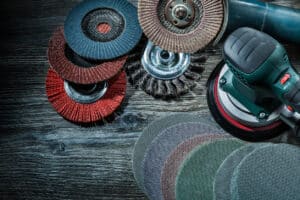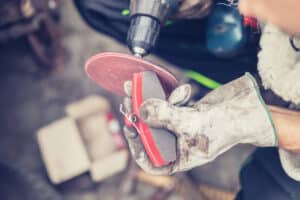How to Choose the Correct Sanding Disc

Having the correct tools for the job is always a necessity in the bodyshop, and this definitely applies when picking out the right sanding discs. Having the correct sanding disc for the job at hand ensures that each and every job can be completed to a high standard with high-quality craftsmanship.
In this guide, we’ll go over everything you need to know to make the right decision when purchasing sanding discs, including an explanation of grit grades and how to know which sanding discs and tools are best for different scenarios. Whether you’re a bodyshop beginner or a professional in the trade, we hope this know-all guide can help you make the best decision for any sanding job you’re tasked with.
When should you use sanding discs?
It’s important to understand when to use sanding discs and when not to. And while each job is different and will call for various methods, the main recommended use of sanding discs is to sand down body filler. They can also sometimes be used for removing rust and other imperfections, although sanding by hand is usually the preferred method in these cases.
Sanding discs can quickly and easily wear down body filler to create a smooth base ready for paint application on larger areas. They can also be used on smaller areas of body filler to help the original paint blend into these spots.
How should you protect adjacent panels when sanding?
Although sanding discs and tools are the main requirements for these jobs, having the right protective tape is also a necessity. Protecting the adjacent panels during the sanding process is vital for achieving a great-quality, consistent finish. Therefore, using tape with tough adhesion around the panels or areas you’re working on is recommended.
At JTAPE, we’ve designed our Premium Cloth Protection Tape to be twice as tough as standard gaffer tape, meaning it can easily protect all surfaces of the car’s exterior when using sanding discs. Quality matters when it comes to auto repair and body shop businesses, and using our tapes will guarantee that the adjacent panels remain free from damage or marks during this process.
The different sanding disc tools for the automotive industry
Within the automotive industry, there are multiple sanding disc tools to choose from. Here, we’ll run you through some of the best and most popular options…

Orbital sander
The two types of orbital sanders are the most commonly used sanding disc tools in the automotive shop arsenal. A regular orbital sander moves in a circular motion, while random orbital sanders move from side to side as they rotate. The main benefit of an orbital sander is that it won’t leave swirl marks on the surface you’re working on.
Both are primarily used for finishing and polishing rather than grinding as the previous two tools are. Because of this, thinner discs made of paper or cloth with either an adhesive back or hook and loop are used with this type of sander.
Angle grinder
After orbital sanders, angle grinders are among the most popular sanding disc tool in many body shops because of their versatility. They can be modified for use with many different types of abrasives, cut-off wheels and polishing discs, meaning they’re incredibly versatile.
Although they’re a popular choice, they can also be dangerous if proper precautions aren’t taken. Always remember to use your guard while the grinder is engaged, wear proper personal protective equipment, and never wear loose clothing whilst operating the grinder.
Die grinder
Die grinders are also a great option as they offer a fast solution for working in hard-to-reach areas because they spin much faster than the typical angle grinder. They’re best for use with smaller discs like mini cut-off wheels, but bear in mind they’ll usually require a backing pad.
Stationary disc sanders
A stationary disc sander is usually configured on a pedestal, workbench, or a combo belt grinder machine. But, unlike the other tools, this static sander requires the use of a rugged PSA disc which is best for working on flat surfaces. For example, stationary disc sanders are perfect for sanding down body filler on single panels.
This sanding machine has a wheel where the abrasive spins while the user rests the panel or piece in front, applying slight pressure to the wheel.

How long do sanding discs generally last?
The length of time your sanding discs will last usually depends on what they’re being used for, and how often. Naturally, the more often they’re used and the pressure that’s placed on them can cause sanding discs to have a much shorter life.
The life of your sanding discs can also depend on which tool they’re used in conjunction with. For example, they can wear down much quicker when using an orbital sander because of the increased pressure.
Sanding discs can last longer with the right maintenance, which includes cleaning off any debris that has been attached to them. This can be done by soaking the disc in water and using a steel brush to remove it from the sandpaper.
How do different sanding grits work?
Grit levels offer a method of classifying the coarseness of different sandpaper. As a general rule, the higher the grit number, the smoother the finish which means that lower sanding grits will have a coarser finish. However, a lower grit will remove the filler at a much faster rate.
In the UK, a lower grit number translates to a coarser grit. Sandpapers are commonly graded as Coarse (40 to 60 grit), Medium (80 to 120), Fine (150 to 180), Very Fine (220 to 240), Extra Fine (280 to 320) and Super Fine (360 and above).
How to choose the correct sanding disc for different applications

As we mentioned earlier, different sanding discs should be used for different applications. Below, we’ll go through the various sanding disc types and their primary applications:
- Resin fibre discs: This heavy-duty abrasive is best used alongside an angle grinder for removing rust or unevenness on steel surfaces.
- Flap discs: Since flap discs are made up of multiple pieces of sandpaper, they’re more durable and therefore suitable for longer-term use.
- Hook and loop discs: These discs are highly versatile and can be used for a wide variety of purposes since they come in so many grit grades. Their almost Velcro-like nature also means they’re relatively easy to swap out.
- Quick change discs: This disc type is generally suited to smaller-scale bodywork. Quick change discs usually have a shorter lifespan, although they can be extremely useful for quick jobs.
- PSA discs: Pressure sensitive adhesive sanding discs are best suited to larger jobs like preparing a panel for painting and are often used with stationary disc sanders. They can also last well over a long period.
- Semi-flexible discs: If you’ve got a tough job to complete, semi-flexible discs are often the best choice. They’re durable, tough, and sturdy, which means they can be used for sanding applications of any scale.
- Surface conditioning discs: This disc type is perfect for when you want to reduce the processing time. This is because they can combine multiple grit levels into one sanding disc. However, these should typically only be used for smoothing, rather than creating a rougher surface.
We hope this guide helps you understand everything that should be considered before beginning the sanding process. From picking out a protective tape to choosing your sanding disc, we’ve included everything you should need to know about sanding down body filler effectively.
Our tape solutions are the perfect tool for completing auto repair and bodywork jobs to a higher standard. Visit our online store to discover the full range of JTAPE products available, or contact us today to find your local distributor.


